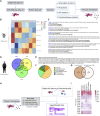Muscle fibro-adipogenic progenitors from a single-cell perspective: Focus on their "virtual" secretome
- PMID: 36200044
- PMCID: PMC9527288
- DOI: 10.3389/fcell.2022.952041
Muscle fibro-adipogenic progenitors from a single-cell perspective: Focus on their "virtual" secretome
Abstract
Skeletal muscle is a highly plastic tissue composed of a number of heterogeneous cell populations that, by interacting and communicating with each other, participate to the muscle homeostasis, and orchestrate regeneration and repair in healthy and diseased conditions. Although muscle regeneration relies on the activity of muscle stem cells (MuSCs), many other cellular players such as inflammatory, vascular and tissue-resident mesenchymal cells participate and communicate with MuSCs to sustain the regenerative process. Among them, Fibro-Adipogenic Progenitors (FAPs), a muscle interstitial stromal population, are crucial actors during muscle homeostasis and regeneration, interacting with MuSCs and other cellular players and dynamically producing and remodelling the extra-cellular matrix. Recent emerging single-cell omics technologies have resulted in the dissection of the heterogeneity of each cell populations within skeletal muscle. In this perspective we have reviewed the recent single-cell omics studies with a specific focus on FAPs in mouse and human muscle. More precisely, using the OutCyte prediction tool, we analysed the "virtual" secretome of FAPs, in resting and regenerating conditions, to highlight the potential of RNAseq data for the study of cellular communication.
Keywords: FAPs; cell-cell communication; extracellular matrix; in silico; scRNAseq; secretome; skeletal muscle.
Copyright © 2022 Negroni, Kondili, Muraine, Bensalah, Butler-Browne, Mouly, Bigot and Trollet.
Conflict of interest statement
The authors declare that the research was conducted in the absence of any commercial or financial relationships that could be construed as a potential conflict of interest.
Figures

Similar articles
-
FACS-isolation and Culture of Fibro-Adipogenic Progenitors and Muscle Stem Cells from Unperturbed and Injured Mouse Skeletal Muscle.J Vis Exp. 2022 Jun 8;(184):10.3791/63983. doi: 10.3791/63983. J Vis Exp. 2022. PMID: 35758697 Free PMC article.
-
Fibro-Adipogenic Progenitors Cross-Talk in Skeletal Muscle: The Social Network.Front Physiol. 2019 Aug 21;10:1074. doi: 10.3389/fphys.2019.01074. eCollection 2019. Front Physiol. 2019. PMID: 31496956 Free PMC article. Review.
-
Fibro-adipogenic progenitors in skeletal muscle homeostasis, regeneration and diseases.Open Biol. 2021 Dec;11(12):210110. doi: 10.1098/rsob.210110. Epub 2021 Dec 8. Open Biol. 2021. PMID: 34875199 Free PMC article. Review.
-
Cellular interactions and microenvironment dynamics in skeletal muscle regeneration and disease.Front Cell Dev Biol. 2024 May 22;12:1385399. doi: 10.3389/fcell.2024.1385399. eCollection 2024. Front Cell Dev Biol. 2024. PMID: 38840849 Free PMC article. Review.
-
Origins, potency, and heterogeneity of skeletal muscle fibro-adipogenic progenitors-time for new definitions.Skelet Muscle. 2021 Jul 1;11(1):16. doi: 10.1186/s13395-021-00265-6. Skelet Muscle. 2021. PMID: 34210364 Free PMC article. Review.
Cited by
-
Abstracts of the 2023 Padua Days of Muscle and Mobility Medicine (2023Pdm3) to be held March 29 - April 1 at the Galileian Academy of Padua and at the Petrarca Hotel, Thermae of Euganean Hills, Padua, Italy.Eur J Transl Myol. 2023 Feb 10;33(1):11247. doi: 10.4081/ejtm.2023.11247. Online ahead of print. Eur J Transl Myol. 2023. PMID: 36786151 Free PMC article.
-
The impact of extracellular matrix proteins on bovine fibro-adipogenic progenitor cell adhesion, proliferation, and differentiation in vitro.Physiol Rep. 2025 May;13(9):e70283. doi: 10.14814/phy2.70283. Physiol Rep. 2025. PMID: 40312265 Free PMC article.
-
Program with last minute abstracts of the Padua Days on Muscle and Mobility Medicine, 27 February - 2 March, 2024 (2024Pdm3).Eur J Transl Myol. 2024 Mar 27;34(1):12346. doi: 10.4081/ejtm.2024.12346. Eur J Transl Myol. 2024. PMID: 38305708 Free PMC article.
-
Dissecting the impact of differentiation stage, replicative history, and cell type composition on epigenetic clocks.Stem Cell Reports. 2024 Sep 10;19(9):1242-1254. doi: 10.1016/j.stemcr.2024.07.009. Epub 2024 Aug 22. Stem Cell Reports. 2024. PMID: 39178844 Free PMC article.
-
Cell type mapping of inflammatory muscle diseases highlights selective myofiber vulnerability in inclusion body myositis.Nat Aging. 2024 Jul;4(7):969-983. doi: 10.1038/s43587-024-00645-9. Epub 2024 Jun 4. Nat Aging. 2024. PMID: 38834884 Free PMC article.
References
-
- Bensalah M., Muraine L., Boulinguiez A., Giordani L., Albert V., Ythier V., et al. (2022). A negative feedback loop between fibroadipogenic progenitors and muscle fibres involving endothelin promotes human muscle fibrosis. J. Cachexia Sarcopenia Muscle 13, 1771–1784. 10.1002/jcsm.12974 - DOI - PMC - PubMed
LinkOut - more resources
Full Text Sources

